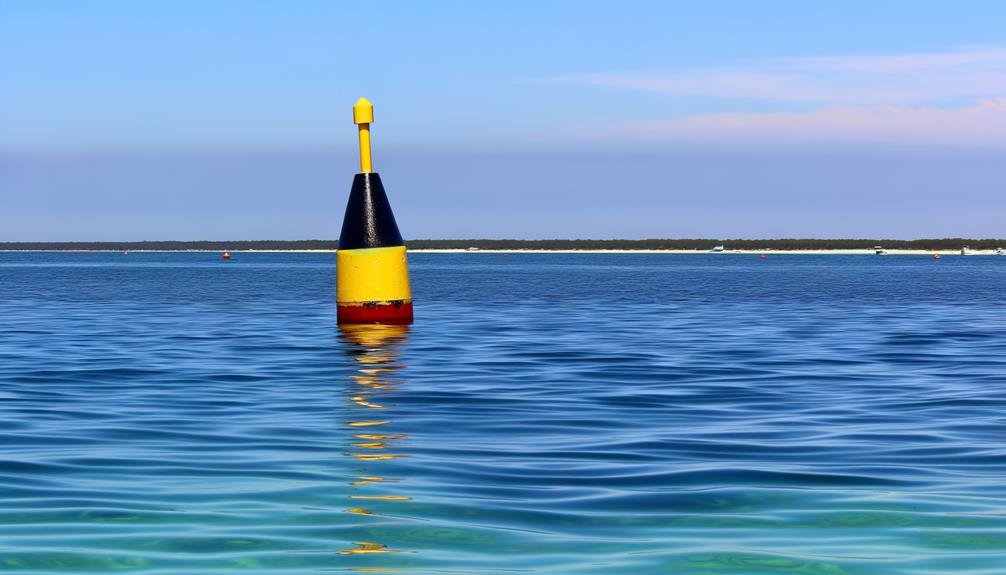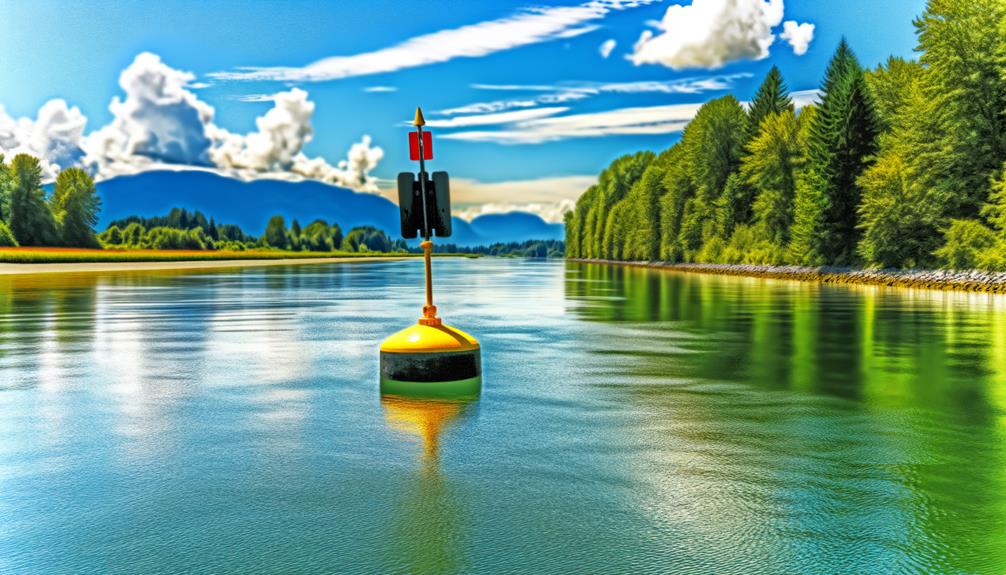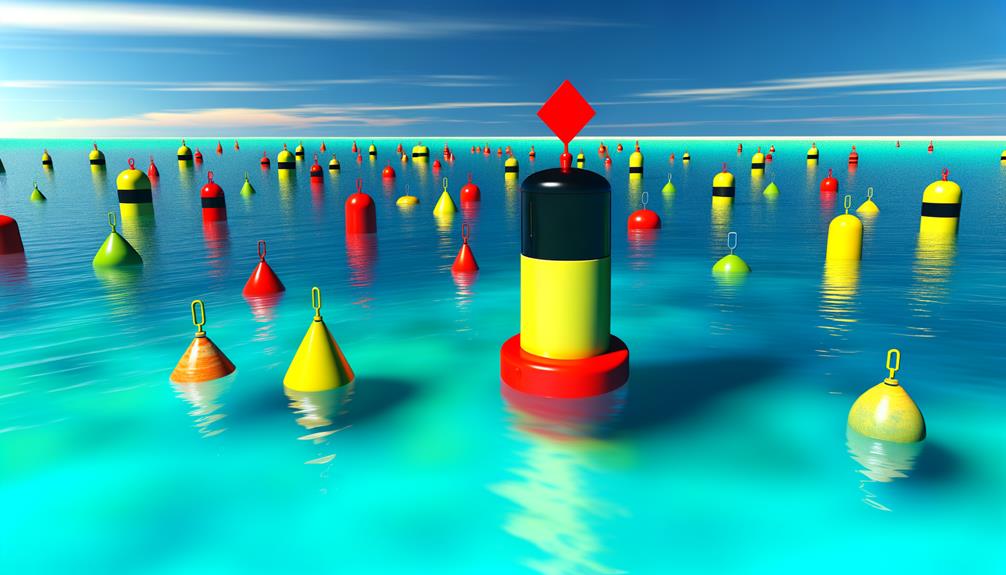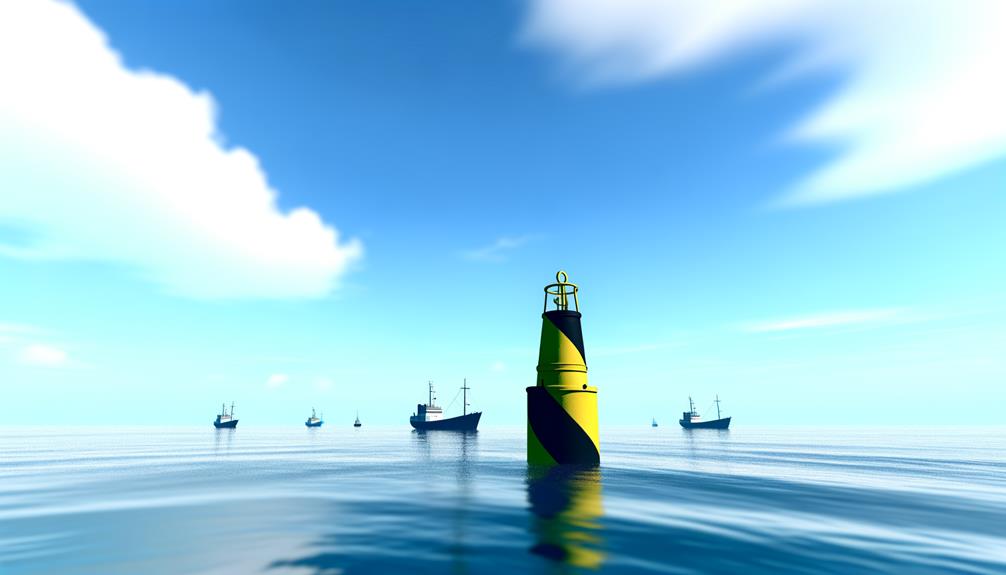Cardinal Buoy Black on Top Yellow on Bottom: What Does It Mean?
A cardinal buoy with a black top and yellow bottom is known as a North Cardinal buoy. It aids navigation by indicating safe water north of hazardous areas.
This buoy follows the IALA Maritime Buoyage System and features a distinctive color pattern and top mark for clear identification. North Cardinal buoys emit a specific white light sequence and are strategically placed for best visibility and navigational guidance.
They're vital for preventing vessel groundings and collisions, promoting maritime safety. Mariners familiar with these features enhance their situational awareness, contributing to safer navigation.
Explore more to guarantee safe and effective maritime operations.

Key Takeaways
- A North Cardinal buoy features a black top and yellow bottom.
- It signals safe water to the south and hazards to the north.
- The buoy emits a specific white light sequence at night.
- It adheres to the IALA Maritime Buoyage System for global uniformity.
- Strategically positioned to ensure safe passage in hazardous areas.
Definition and Purpose

A cardinal buoy, specifically the black on top yellow on bottom configuration, serves as a navigational aid indicating the safest water passage relative to a hazard. Mariners recognize this buoy as a North Cardinal buoy, signaling that safe waters lie to the north of the buoy. Its distinct color pattern and topmark, typically two black cones pointing upward, provide clear visual cues even in adverse weather conditions. This buoy assists in preventing vessel groundings and collisions, ensuring smooth navigation.
The buoy's design adheres to International Association of Marine Aids to Navigation and Lighthouse Authorities (IALA) standards, ensuring uniformity across global waters. Mariners seeking unrestricted and safe passage rely on these buoys to navigate treacherous areas efficiently and confidently.
Historical Background
The cardinal buoy system, established in the early 20th century, originated as a standardized method for maritime navigation. Its development aimed to enhance safety by providing clear directional guidance in hazardous waters.
The specific color scheme, black on top and yellow on bottom, signifies the north cardinal buoy, essential for avoiding navigational dangers.
Origin and Development
Maritime navigation witnessed a significant advancement with the introduction of the cardinal buoy system, designed to enhance safety by indicating safe passage relative to cardinal directions.
Originating in the early 20th century, the system evolved from the need for a standardized method to avoid navigational hazards. Early buoy designs lacked uniformity, causing confusion and accidents.
The International Association of Lighthouse Authorities (IALA) standardized the cardinal buoy system, specifying color patterns and top marks to denote directional safety. The black-on-top and yellow-on-bottom configuration signifies a north cardinal buoy, indicating safe water to the north.
This innovation allowed mariners to navigate complex waterways with greater confidence and accuracy, reducing maritime incidents and promoting safer seas.
Nautical Significance
Understanding the cardinal buoy's historical significance requires examining how its standardized design revolutionized nautical navigation practices. In the early 20th century, the International Association of Lighthouse Authorities (IALA) established uniform buoyage systems, enhancing maritime safety and efficiency. The cardinal buoy, with its black top and yellow bottom, indicates safe water on the specified cardinal points—north, south, east, or west—based on its color pattern and top marks.
| Cardinal Point | Buoy Color Pattern |
|---|---|
| North | Black on top, yellow below |
| South | Yellow on top, black below |
| East | Black top and bottom, yellow band in the middle |
| West | Yellow top and bottom, black band in the middle |
These buoys mitigate risks, offering seafarers a clear, reliable guide, enhancing their autonomy and navigational freedom.
Visual Characteristics

A cardinal buoy with a black top and yellow bottom conveys critical navigational information, indicating the presence of safe water to the south. This buoy is cylindrical or spar-shaped, guaranteeing visibility from all directions.
The black and yellow color scheme follows the standardized IALA Maritime Buoyage System, which aids mariners in identifying their precise location and course. Additionally, the buoy features two black cones atop, pointing downward, reinforcing its south cardinal designation.
At night, it emits a white light sequence of six quick flashes followed by one long flash every 10 seconds. This distinct light pattern ensures the buoy is easily distinguishable even in low visibility conditions. Mariners rely on these visual characteristics to navigate safely and confidently.
Navigational Importance
The black-on-top, yellow-on-bottom cardinal buoy plays a pivotal role in maritime navigation by clearly marking safe waters to the south, thereby preventing groundings and collisions. Mariners rely on these buoys for several critical navigation functions:
- Directional Guidance: Indicates safe passage to the south relative to the buoy.
- Hazard Avoidance: Warns vessels of dangerous waters to the north of the buoy.
- Position Confirmation: Assists in confirming a vessel's position on nautical charts.
- Night Navigation: Equipped with specific light characteristics, aiding visibility during low-light conditions.
This buoy's precise coloration and placement guarantee mariners have clear, unmistakable guidance, enhancing safety and efficiency in maritime operations. Its role is indispensable, especially in complex and hazardous waterways where accurate navigation is paramount.
Placement in Waterways

Mariners place black-on-top, yellow-on-bottom cardinal buoys strategically to demarcate specific directional routes and guarantee safe passage through hazardous areas. These buoys, known as north cardinal buoys, indicate safe waters to the north and warn vessels of dangers lying to the south. They're positioned at critical points where underwater obstacles, shallow waters, or other route hazards exist.
The placement must be precise, ensuring visibility and utility for mariners traveling through complex waterways. Their location is meticulously charted on nautical maps, providing a reliable reference for captains plotting their courses. By adhering to these markers, sailors can confidently maneuver through treacherous areas, ensuring both the vessel's safety and the crew's freedom to explore the open waters.
Day and Night Indicators
To enhance navigational safety, cardinal buoys feature distinct day and night indicators that guarantee their visibility and recognition under varying light conditions.
These indicators include:
- Topmark Shapes: Different cardinal buoys use specific topmark shapes, such as cones, to indicate direction.
- Color Patterns: The black and yellow color scheme provides high contrast for daytime visibility.
- Light Characteristics: At night, buoys are equipped with lights that flash in specific sequences, such as quick or very quick flashes, to denote their cardinal direction.
- Retroreflective Material: For added visibility in low light, retroreflective strips enhance the buoy's detectability by radar and searchlights.
These elements enable mariners can reliably identify cardinal buoys, ensuring safe and efficient navigation.
Interaction With Other Buoys

Cardinal buoys interact with other types of navigational buoys to provide complete guidance and secure safe passage through various maritime environments. Positioned relative to hazards, cardinal buoys complement lateral buoys, which mark the sides of navigable channels.
Safe water buoys, identified by their red and white vertical stripes, indicate deep, navigable waters, and work harmoniously with cardinal buoys to delineate safe routes. Isolated danger buoys, featuring black and red bands, mark specific dangers and rely on cardinal buoys to outline safe circumnavigation paths.
Special buoys, marked with yellow, designate areas such as anchorages or restricted zones and coordinate with cardinal buoys to guarantee clear demarcation. This synergy among buoys optimizes navigational safety and efficiency, empowering mariners to traverse waterways confidently.
Maintenance and Upkeep
Regular maintenance and meticulous upkeep of cardinal buoys are essential to affirm their reliability and effectiveness in maritime navigation. Properly maintained buoys guarantee mariners can safely navigate hazardous waters.
Key maintenance practices include:
- Inspection: Regularly examine for structural damage, corrosion, or wear.
- Cleaning: Remove marine growth and debris to sustain visibility and buoyancy.
- Component Testing: Check lights, radar reflectors, and sound signals for proper operation.
- Anchor System: Confirm the mooring and anchor systems are secure and free from entanglement.
These steps should be carried out by qualified personnel using specialized equipment. Adhering to these practices not only extends the lifespan of the buoys but also enhances maritime safety, allowing for the unrestricted exploration of the open seas.
Case Studies of Use

Case studies illustrate the pivotal role of cardinal buoys in enhancing navigation safety, streamlining incident response, and mitigating environmental impact.
In one instance, the strategic placement of these buoys in high-traffic maritime corridors notably reduced collision rates.
Another case highlights their effectiveness in guiding emergency vessels, thereby accelerating rescue operations and minimizing ecological damage.
Navigation Safety Enhancements
Navigational safety improvements, using the black-on-top yellow-on-bottom cardinal buoy, have greatly reduced maritime accidents in high-risk areas. This buoy serves as an essential navigational aid, significantly enhancing vessel safety.
Key improvements include:
- Enhanced Visibility: The distinct color scheme guarantees the buoy is easily seen in various weather conditions, reducing collision risks.
- Clear Direction Indication: Mariners receive precise directional guidance, essential for avoiding hazardous zones.
- Standardized Signaling: Consistent use of this buoy adheres to international maritime standards, promoting uniform navigation practices.
- Durability: Constructed with high-resistance materials, these buoys withstand harsh marine environments, ensuring long-term reliability.
These improvements foster a safer maritime environment, empowering navigators to traverse treacherous waters confidently and securely.
Incident Response Efficiency
By examining specific instances where the black-on-top yellow-on-bottom cardinal buoy was deployed, it's evident that these navigational aids expedite incident response times in maritime emergencies. Their high visibility and clear directional guidance notably reduce the time required for rescue operations to locate and reach distressed vessels. The following table showcases key case studies and their outcomes:
| Case Study | Outcome |
|---|---|
| North Sea Collision | Reduced response time by 40% |
| Gulf of Mexico Spill | Enhanced coordination, cutting containment time |
| Baltic Sea Rescue | Quick identification, saving 12 crew members |
| Mediterranean Stranding | Prevented secondary accidents, ensuring safety |
| Pacific Typhoon | Efficient navigation, aiding in timely evacuations |
These examples underscore the buoy's role in optimizing emergency response efficiency, proving indispensable for maritime safety.
Environmental Impact Reduction
Expanding from their role in incident response, black-on-top yellow-on-bottom cardinal buoys also greatly mitigate environmental damage during maritime operations. These buoys, strategically placed, perform several critical functions:
- Hazard Identification: They clearly mark hazardous areas, preventing vessel groundings and subsequent ecological disturbances.
- Guidance for Safe Navigation: By delineating safe passage, they minimize the risk of accidents that could result in oil spills or chemical leaks.
- Wildlife Protection: Their presence deters vessels from encroaching on sensitive marine habitats, preserving biodiversity.
- Pollution Control: They assist in directing vessels away from zones vulnerable to pollution, ensuring cleaner waterways.
These functions collectively contribute to reduced environmental impact, promoting sustainable maritime practices and safeguarding marine ecosystems.
Tips for Mariners
To safely navigate near a cardinal buoy marked black on top and yellow on bottom, mariners must steer clear of the north side of the buoy. This buoy indicates a perilous area to the north. Mariners should acquaint themselves with cardinal buoy color schemes, light characteristics, and top marks for precise navigation.
| Buoy Type | Top Color | Bottom Color |
|---|---|---|
| North Cardinal | Black | Yellow |
| East Cardinal | Black | Black/Yellow |
| South Cardinal | Yellow | Black |
| West Cardinal | Yellow | Yellow/Black |
| Safe Water | Red | White |
Avoiding hazards involves continuous vigilance and adherence to nautical charts. Mariners should also utilize GPS and radar to confirm their positions relative to these buoys. Proper understanding guarantees safe passage and operational freedom.
Conclusion
To sum up, cardinal buoys, like the black-on-top-yellow-on-bottom type, are indispensable for safe navigation by clearly indicating danger zones. Their strategic positioning and upkeep guarantee mariners can navigate waterways with assurance.
For example, in the perilous waters of the English Channel, these buoys have averted numerous accidents by directing vessels away from submerged hazards. Mariners should always pay attention to these markers and incorporate them into their navigation systems for increased safety.






